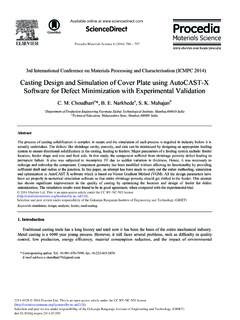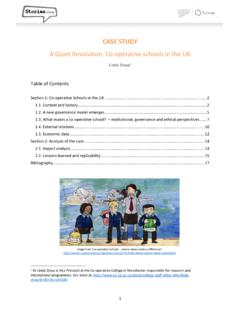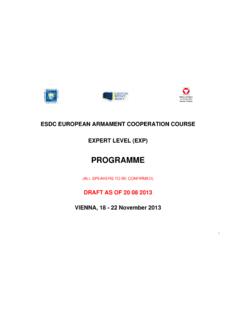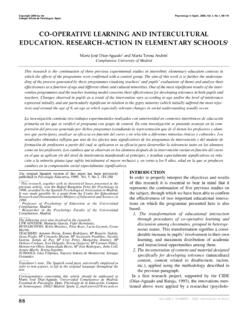Transcription of Evaluating the Industrial Co-operative Research Networks ...
1 See discussions, stats, and author profiles for this publication at: the Industrial Co-operative Research Networks How doStructures and interactions contribute to Success of the programme ?ArticleCITATIONS0 READS293 authors, including:Some of the authors of this publication are also working on these related projects:Windows of Opportunity in Cluster Policy: Germany s Leading-Edge Cluster s programme View projectGermany-wide survey of university professors and leading scientist at the non-university Research institutions View projectMichael RothgangRWI - Leibniz Institute for Economic Research74 PUBLICATIONS 170 CITATIONS SEE PROFILEAll content following this page was uploaded by Michael Rothgang on 17 November user has requested enhancement of the downloaded file.
2 Evaluating the Industrial Co-operative Research Networks How do Structures and interactions contribute to Success of the programme ? Michael Rothgang. Matthias Peistrup, Bernhard Lageman1 Abstract Innovation Networks can contribute both to the creation of new knowledge and to the diffu-sion of existing and newly created knowledge. The Industrial Co-operative Research (ICR) programme aims at both targets at the same time. The success of this programme depends essentially on the performance of the innovation Networks which have developed in close as-sociation with public financing.
3 This contribution presents results obtained from Evaluating network activities at the project level. The participation of firms in several network activities and the patterns of adoption of the new knowledge generated are analysed. By applying probit and zero-inflated Poisson regressions, we find that closeness of cooperation between Research institutes and firms both in the creation and diffusion of knowledge is related with the subse-quent use of project results. Keywords network evaluation; Industrial Collective Research ; Zero-inflated Poisson Regression JEL: O38, L60 1 All RWI Essen.
4 Contact: RWI Essen, Hohenzollernstr. 1-3, 45128 Essen. Email: Rothgang/Peistrup/Lageman 2 1. Introduction Evaluations of the performance of Research Networks are confronted with conceptual and em-pirical challenges. For network evaluations the same is true as for technology policy evalua-tions in general (Bozeman, Melkers 1993): Evaluation tools are not hammers and R&D net-works are not nails.
5 The evaluation concept has to be adapted to the individual Research net-work assessed. Especially, two questions have to be addressed in Evaluating Research net-works: which approach(es) should be used to evaluate the network , its structure and the dy-namics of network relations, and how do we measure the outcome of the network activities? Against that background, our contribution looks at experiences and results from the evalua-tion of the state funded programme of Industrial collective Research (ICR) in Germany.
6 The programme promotes precompetitive, cooperative Research activities of business firms and Research institutes. It aims to increase innovativeness of small and medium sized enterprises (SMEs). Although the Research needs of SMEs are the main target, large firms are not ex-cluded from participation in network activities. In fact they are engaged in manifold ways in ICR. The practical importance of ICR should not be underestimated: Starting in 1954, at least billion have been spent in Research projects and a major share of the Research activities in German engineering faculties have been financed by this programme .
7 In ICR, Research institutes perform Research on topics which are relevant for business firms, mainly aiming at the traditional sectors of the manufacturing industry. Firms take part in these activities by offering Research ideas, accompanying the Research projects, and by making use of the Research results and developing them towards economic use. In this network , re-search associations (RA) which are organised corresponding to branches or technology fields form the organisational backbone.
8 Research institutes perform the Research activities and con-tribute to the distribution of project results. Evaluating Industrial Competitive Research 3 Two questions are analyzed in our paper: We discuss the network structure of ICR and ask, which evaluation design is suitable to evaluate the performance of the Research network on the micro-level. Based on these considerations, we choose a project oriented approach to analyse the characteristics of interactions and interactive structures and ask whether they can provide an explanation of innovative success of the network .
9 We use a unique database including data on more than 500 projects with termination in the years 2003 to 2005 which is based on an online survey conducted in the course of the evaluation project. This dataset provides institute and project specific information for several aspects of network activities as well as informa-tion on later use of project specific Research results by business firms. Our paper consists of four subsequent sections. In section two, the network structure of ICR is outlined.
10 On that background, the principal tasks and challenges of Evaluating the network activities triggered by the programme as well as approaches to the evaluation we chose are discussed. Section three gives an outline of the data base and discusses the structures of ICR, the network dynamics, and interactions taking place. In section four, the relationships be-tween structures, processes and use of Research results in business firms are analysed by using probit and zero-inflated Poisson regressions.



















